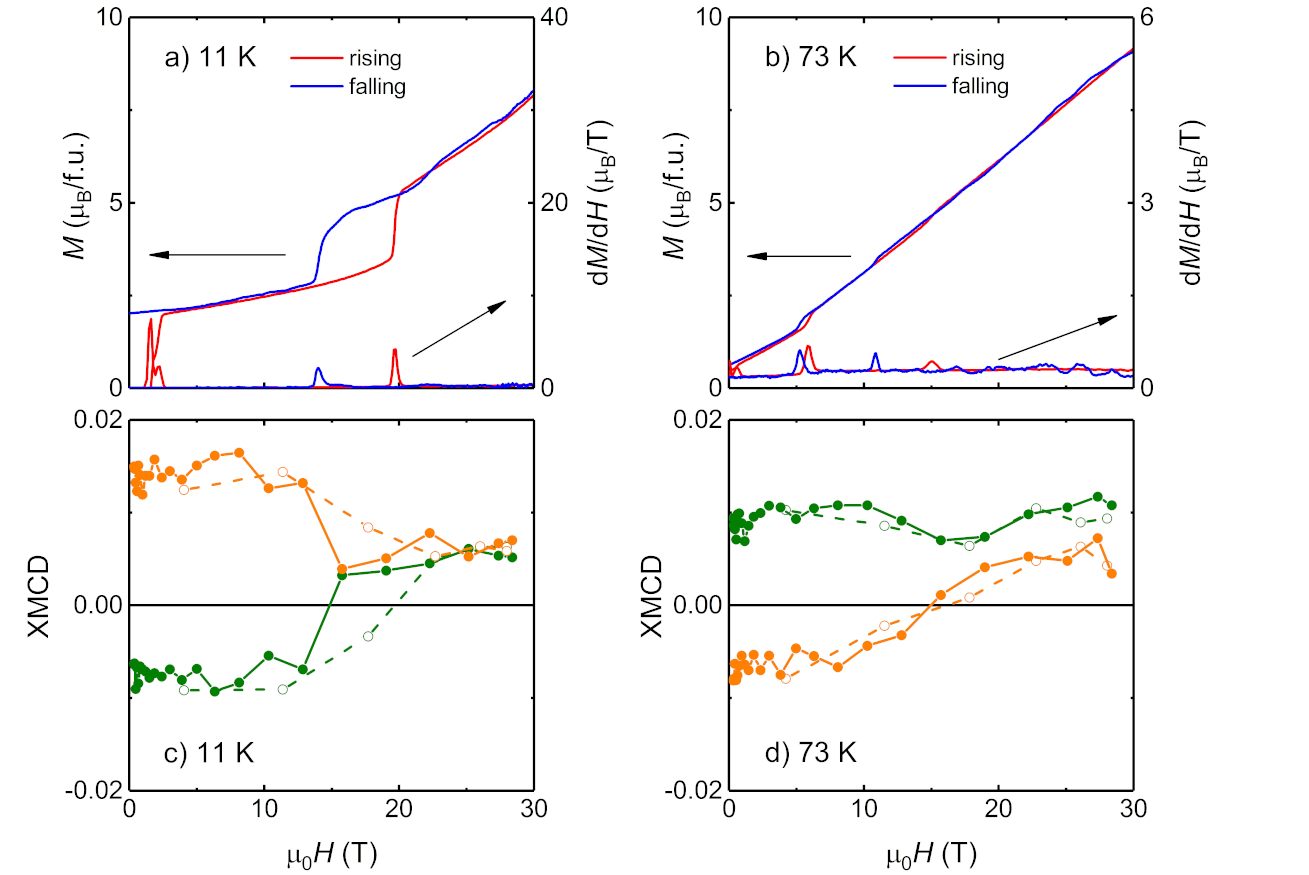Denis Gorbunov, HLD Dresden.
Intermetallic compounds based on 3d and 4f elements combine high magnetic ordering temperatures, typical of 3d metals, and the large magnetic anisotropy of the magnetic rare-earths elements. The application of external magnetic fields tunes the exchange and anisotropy interactions and frequently leads to field-induced transitions. A detailed understanding of the magnetization process requires a microscopic technique, such as magnetic x-ray scattering, in order to follow the evolution of the magnetic structure in the applied field. Yet, it is exactly the strength of the interactions that makes such a study challenging due to the high magnetic fields needed.
HoFe5Al7 is a strongly anisotropic ferrimagnet. At 2 K, it displays field-induced phase transitions at 13-20 and 34-38 T. We performed x-ray magnetic circular dichroism (XMCD) experiments in pulsed magnetic fields up to 30 T to follow the rotations of the individual sublattice magnetizations. Panels (a) and (b) of the figure show the bulk magnetization and its field derivative for a field applied along the easy magnetization direction above and below the compensation temperature of 65 K. At 11 K, a first-order phase transition is observed between 14 and 19.5 T. At 73 K, two weak transitions can be resolved between 5.5 and 6 T and between 11 and 15 T. The field-dependent Fe- and Ho-sublattice magnetizations inferred from the XMCD data both rotate at the phase transition at 11 K, whereby the Fe magnetization reverses its sign (panel c). Above the compensation temperature, the Ho moment starts to increase continuously above 6 T, reversing sign at about 16 T. For the Fe moment, two small hysteresis loops open at around 10 and 27.5 T, concomitant with the beginning and the end of the reversal of the Ho magnetization.
Modeling of the individual sublattice magnetizations allowed us to determine the in-plane anisotropy constant, K ≈ 0.5 MJ/m3, close to the ground state. The additional field-induced transition observed above the compensation temperature can be explained by the fact that the Ho-sublattice magnetization is no longer rigid, as the applied field acts against the Ho-Fe molecular field in this temperature range. This study provides the first microscopic insight into the magnetization process of a strongly anisotropic ferrimagnet in pulsed magnetic fields.

Figure: Bulk magnetization and field derivative of (a), (b) the magnetization of HoFe5Al7 and (c), (d) field dependences of the amplitudes of the Fe-like (green) and Ho-like (orange) components below and above the compensation temperature. Open symbols and dashed lines, rising field; full symbols and lines, decreasing field.
Microscopic Nature of the First-Order Field-Induced Phase Transition in the Strongly Anisotropic Ferrimagnet HoFe5Al7, D. I. Gorbunov, C. Strohm, M. S. Henriques, P. van der Linden, B. Pedersen, N. V. Mushnikov, E. V. Rosenfeld, V. Petříček, O. Mathon, J. Wosnitza, and A. V. Andreev, Phys. Rev. Lett. 122, 127205 (2019). Link
Contact: D.Gorbunov@hzdr.de






